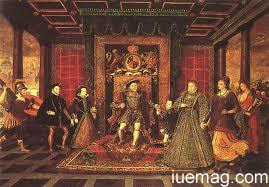

Infamous for having been the King who ruled alongside six different wives, King Henry VIII is usually portrayed
as a dark villain - slaying and tossing aside wives at his whim. But was he truly a vindictive and malicious ruler,
or one that was tragically romantic and used by those trying to elevate their status in the kingdom?
History shows that the men surrounding Henry as his advisers were desperately seeking to elevate their own families statuses. Thomas Cromwell, Thomas Cranmer, the Howard family (including the Boleyn's), the Seymour family... the list goes on and on. The men in these families pounced on Henry's weakness of women, parading their daughters, nieces, and even granddaughters in front of Henry, tempting and taunting him.
History shows that the men surrounding Henry as his advisers were desperately seeking to elevate their own families statuses. Thomas Cromwell, Thomas Cranmer, the Howard family (including the Boleyn's), the Seymour family... the list goes on and on. The men in these families pounced on Henry's weakness of women, parading their daughters, nieces, and even granddaughters in front of Henry, tempting and taunting him.

History books prefer to depict him as a horrifying monster - a man who slayed not only his wives,
but any man or woman in his country that defied, disrespected, or betrayed his trust.
His obsession over Anne Boleyn created shockwaves around the country as he openly defied the Pope and declared himself the head of the Church of England.
It was generally accepted that Henry tossed aside his wives when a new woman met his fancy.
Authors such as Philippa Gregory (author of The Constant Princess, The Other Boleyn Girl, and The Boleyn Inheritance) and Diane Haeger (author of The Queen's Mistake), however, challenge the theory of a monstrous King and present a different one: a King who was used and abused by those in power in his own court, a man who was desperately seeking love and affection, ruled by his own heart and betrayed by those closest to him.
Could it be that a man as powerful as the King of England could be ruled by his own heart? He caused chaos in his own country by turning his back on the Pope - all for a woman that seduced him into leaving his wife and Queen of twenty-four years. He beheaded Anne Boleyn and Catherine Howard on claims of adultery - is that truly so difficult to sympathize with?
He was the King of England and had all the power in the country and he was betrayed by the women he loved. Which of us haven't, for a moment, fantasized over the vindication of our own broken hearts? Imagine if for a moment we did have the power to punish for betrayal, with no fear of consequence. Would we not be tempted to take justice into our own hands?
Authors such as Philippa Gregory (author of The Constant Princess, The Other Boleyn Girl, and The Boleyn Inheritance) and Diane Haeger (author of The Queen's Mistake), however, challenge the theory of a monstrous King and present a different one: a King who was used and abused by those in power in his own court, a man who was desperately seeking love and affection, ruled by his own heart and betrayed by those closest to him.
Could it be that a man as powerful as the King of England could be ruled by his own heart? He caused chaos in his own country by turning his back on the Pope - all for a woman that seduced him into leaving his wife and Queen of twenty-four years. He beheaded Anne Boleyn and Catherine Howard on claims of adultery - is that truly so difficult to sympathize with?
He was the King of England and had all the power in the country and he was betrayed by the women he loved. Which of us haven't, for a moment, fantasized over the vindication of our own broken hearts? Imagine if for a moment we did have the power to punish for betrayal, with no fear of consequence. Would we not be tempted to take justice into our own hands?
Copyrights © 2025 Inspiration Unlimited - iU - Online Global Positivity Media
Any facts, figures or references stated here are made by the author & don't reflect the endorsement of iU at all times unless otherwise drafted by official staff at iU. A part [small/large] could be AI generated content at times and it's inevitable today. If you have a feedback particularly with regards to that, feel free to let us know. This article was first published here on March 2012.
Overthinking? Uninspired? Brain Fogged?
Let's Reset That! Try iU's Positivity Chat NOW!

All chats are end-to-end encrypted by WhatsApp and won't be shared anywhere [won't be stored either].


